Review: 2025 Lexus LC 500 Convertible
Not every sports car has to chase lap times. Building sporty vehicles with the goal of ultimate performance can lead to harsh rides, restrictive seats, high-strung powertrains, and loud cabins. They can be very rewarding to drive at the limit, but they can also be exhausting as everyday drivers, so much so that you may avoid getting behind the wheel… But you’ll always want to drive the 2025 Lexus LC 500 convertible.
The LC 500 droptop gives up some of that ultimate performance potential for a smooth ride and a relaxed overall character. It also focuses on some of the best parts of the sports car experience to make it one of the most pleasant and rewarding cars to drive on a regular basis
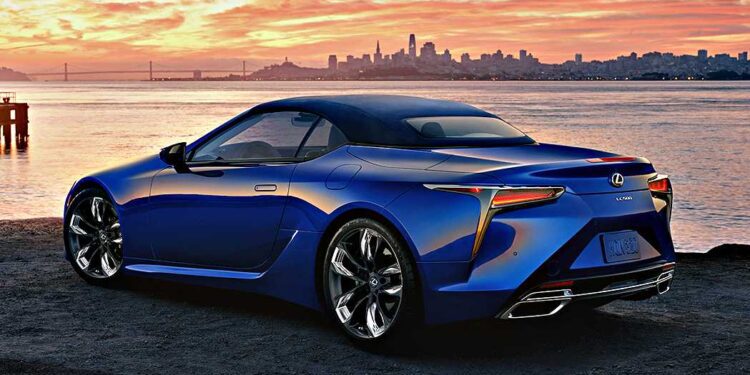
An Everyday Sports Car
It’s easy to fall in love with the LC at a single glance. It sits low and wide, with broad hips fronted by large brake cooling scoops. The nose features an attractive, wide-mouth version of the Lexus spindle grille flanked by squinting LED headlights that drop down into front air intakes. It looks good top up or down, and the soft top is available in four complementary colors. The top can be operated at speeds up to 31 mph and takes 16 seconds or less to raise or lower.
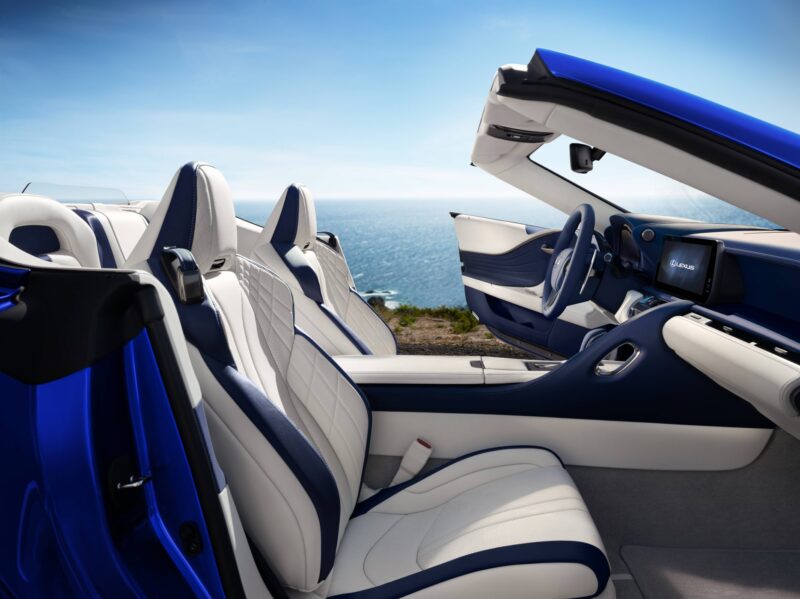
My test car is especially attractive with its Iridium paint (a new color this year), blue top, and white and blue semi-aniline leather interior that imparts a decidedly nautical look. Both the interior and exterior colors are available only in the LC’s Bespoke Build Package that costs $5,500 and comes with dark smoked chrome trim and black accents, and offers the choice of red or blue soft-top colors and three wheel designs.
If the styling doesn’t get you, the V8’s purr will. I hop into the LC, buckle myself in, hit the start button, and the direct-injected 5.0-liter V8 fires to life with a low burble. When I dig into the throttle, the engine emits a note that exists somewhere between NASCAR stocker and refined luxo-cruiser. It’s one of the best-sounding engines on the market, and it’s only enhanced by the active exhaust system that opens a computer-controlled valve at higher revs, as well as the satisfying crackles that sneak out between the smooth shifts of the 10-speed automatic transmission.
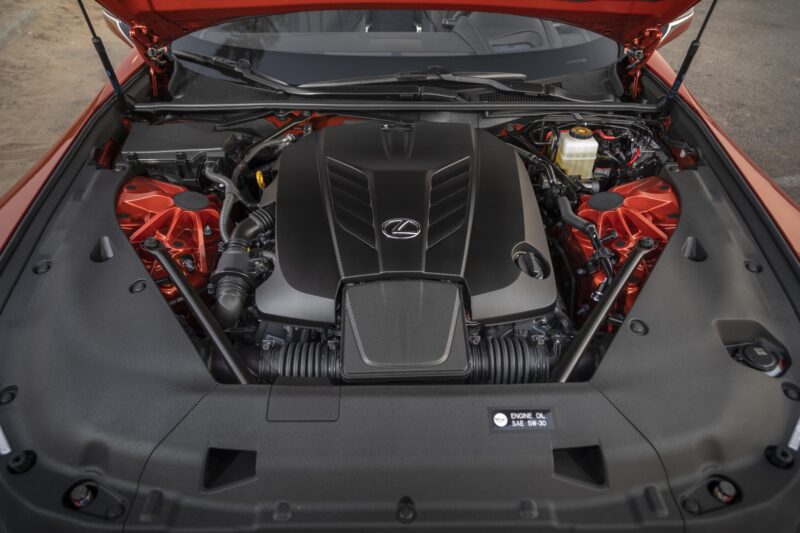
The V8 is no slouch in terms of power either. It spins up 471 horsepower at 7100 rpm and 398 pound-feet of torque at 4800 rpm. Without the benefit of the low-end torque supplied by today’s turbocharged engines, the power is strong, but it builds rather than arriving with a wallop right off the line. It motivates 4,500 pounds of Japanese luxury droptop from 0-60 mph in 4.6 seconds, which is certainly quick but not in the ballpark of the Porsche 911 or today’s high-output electric cars. It tops out at an electronically limited 168 mph.
While the power is inviting, the LC 500’s dynamics calling card is its ride quality. It’s set on low-profile 21-inch wheels and tires, but the LC’s double-joint multilink front and multilink rear suspension, with adaptive dampers all around, soaks up bumps like a mainstream sedan. Most sports cars lean toward firm suspensions that leave me wanting to use the softest setting of their adaptive dampers. In general, I prefer the firmer damper setting in the LC 500 convertible that never skews toward overly firm.
For commuting, the base suspension tune works well, but I want the Sport setting when driving on twisty roads. The firmer damper setting helps control some of the LC’s body lean, enhancing the car’s natural athleticism. To make up for the loss of the top, Lexus adds underbody bracing, including a rear suspension tower and V-brace, all of which do a good job of limiting body quake over bumps.
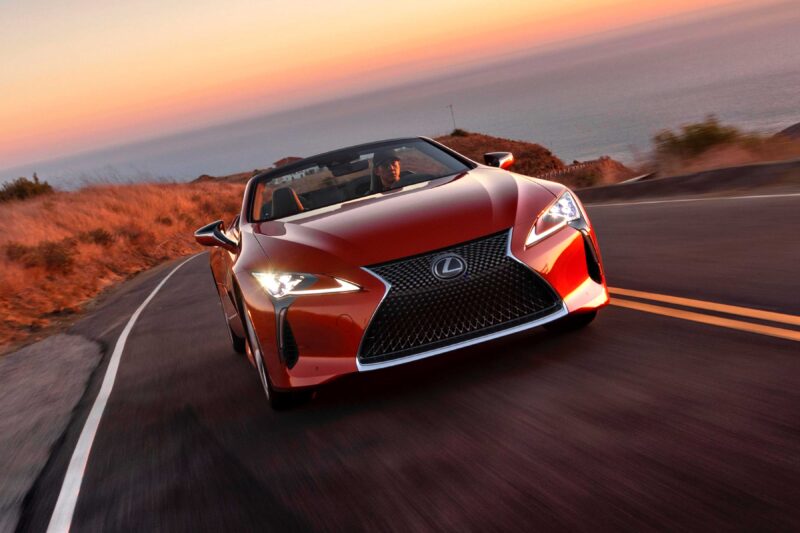
After its initial lean, the Sport setting helps the LC’s poise in corners, and it rotates predicably. The 245/35R21 front and 275/30R21 rear Michelin Pilot Sport S 5 summer performance tires provide good grip, and the steering has some welcome heft and quick, controlled reactions. An available limited-slip rear differential will help it accelerate more briskly on corner exit, but my car doesn’t have it.
The brakes are pretty capable, too. They’re sizable, with 15.7-inch front rotors pinched by six-piston calipers and 14.1-inch rear rotors clamped by four-piston calipers, and will stand up to a good amount of abuse on any road. However, they can fade under the duress of track duty.
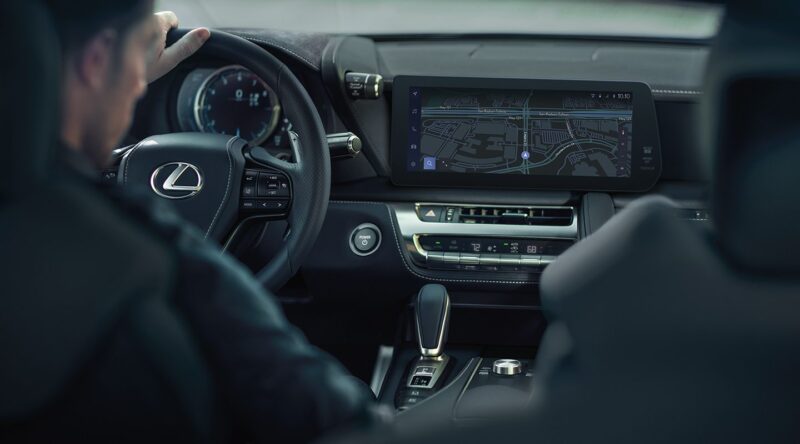
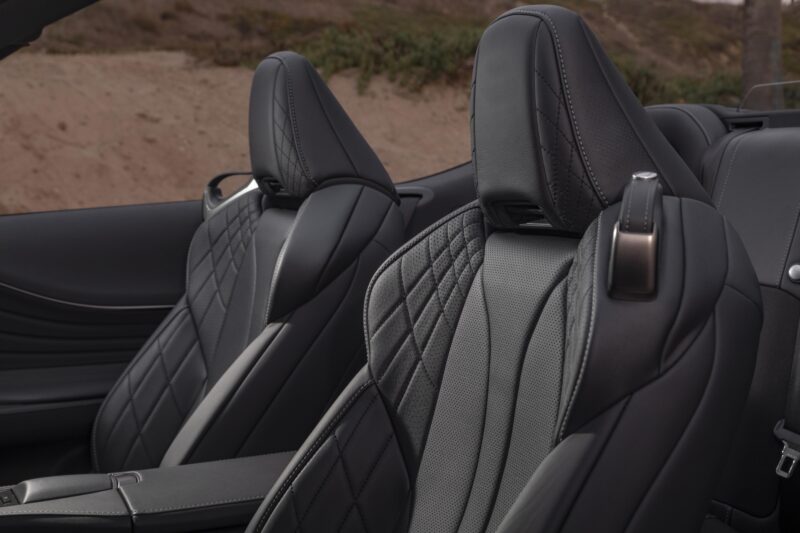
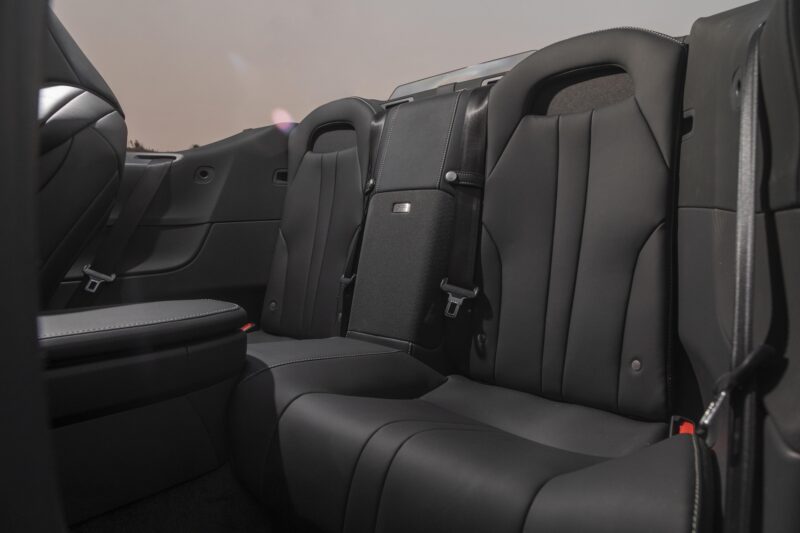
Mostly, though, the LC 500 likes to remain subdued, and the cabin helps with its relaxing nature. The top has three layers of cloth and a layer of sound deadener, and Lexus outfits the LC with standard active noise cancellation. A wind deflector also blocks noise when the top is down. That all makes conversion possible with the top down, and the cabin becomes downright quiet with the top up.
Lexus calls the LC a four-seater, but only two are realistic, and the “back seats” are barely deep enough to fit a rollaboard suitcase, let alone a person. Front riders are surrounded by standard leather and available softer semi-aniline leather upholstery, and they get eight-way power adjustments and standard heating and ventilation for the spacious and comfortable front buckets. The trunk, however, is tiny with just 3.4 cubic feet of space.
The driver interacts with one of the most attractive, watch-like analog instrument clusters left on the market, as well as a quick-acting 12.3-inch touchscreen. Also standard are wireless Apple CarPlay and Android Auto, a satellite radio trial, and available connected services through a 4G network. Spending an extra $1,220 brings an excellent 915-watt Mark Levinson audio system, and a head-up display is available for $900.
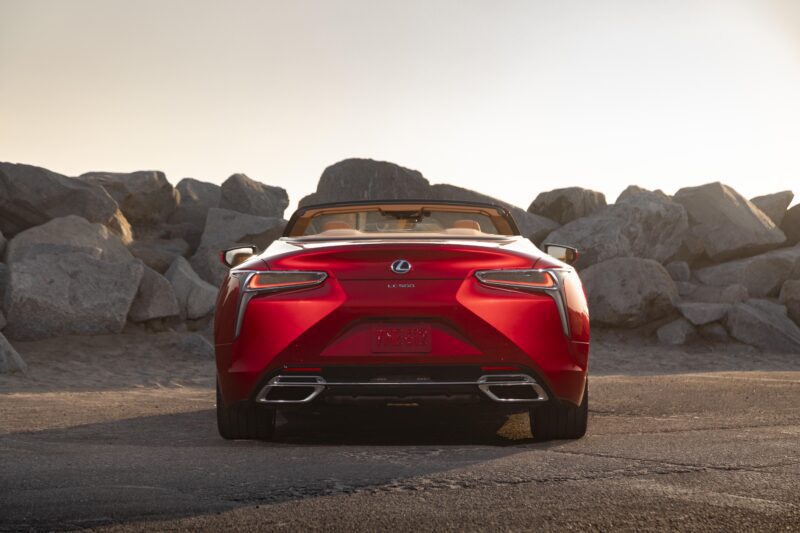
The LC also comes with a good set of safety features that includes Lexus Safety System+ 2.5, which includes automatic emergency braking with pedestrian detection and cross-traffic mitigation, emergency steering assist, adaptive cruise control, lane keep assist, and road sign recognition. Blind-spot monitors, rear cross-traffic alerts, a surround-view camera system, and front and rear parking sensors are also standard.
The 2025 Lexus LC 500 convertible starts at $107,800, including a $1,350 destination fee. That’s $7,500 more than the LC 500 coupe for the joy of top-down driving. The LC 500 convertible is an old-school sports car in the mold of the Mercedes-Benz SL-Class: comfortable, relaxing, and powerful. It’s not a track machine, but track machines can be taxing to drive. Instead, the LC 500 invites you to drive it every day and enjoy every minute of it.
View All Lexus LC500s For Sale
Images: Lexus
Tags: Featured
Related Articles
Review: 2025 Mercedes-Benz GLS 580 4Matic
by Kirk Bell
in Mercedes-Benz News, Reviews
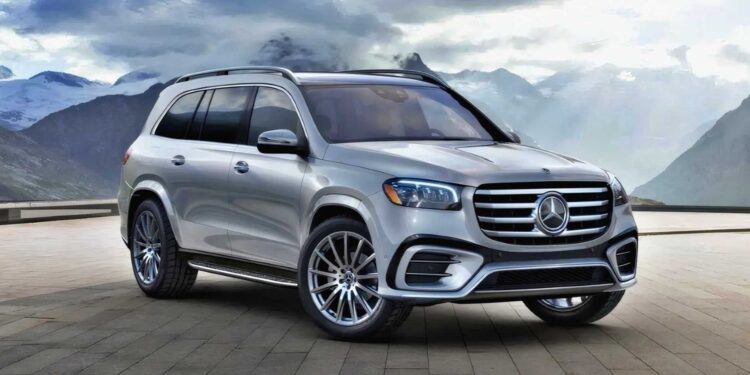
Eating Up Monotonous Miles
The drive from Milwaukee to St. Louis astounds with its monotony. It’s a six-hour journey with little to take in but corn fields and boredom. It’s a lot better with good friends, a smooth ride, and a spacious, comfortable cabin. By those measures, it’s hard to find a better road-trip vehicle than the 2025 Mercedes-Benz GLS 580 4Matic.
But the GLS has more than just the technology and luxury for a comfortable cruise. It also boasts strong power, plentiful space for up to seven passengers, stout towing capacity, and even some off-road capability. It’s good that it’s so versatile because it’s also expensive. It starts at $115,950, including a $1,150 destination charge, and my road-trip tester checked in at $126,610 with a few options.
The power is not only plentiful but smooth. Under the domed and ridged hood lurks Mercedes’ familiar twin-turbocharged 4.0-liter V8. Here it spins up 510 horsepower and 538 pound-feet of torque, and that’s aided by a 48-volt mild hybrid system that can chip in 21 horsepower and 184 pound-feet of torque to get going
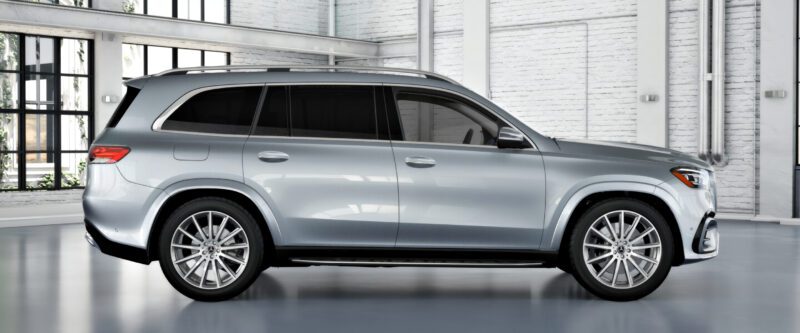
A real-time power meter showed that I used only about 30 horses and 150 pound-feet of torque for much of the highway portion of my road trip, but it was easy to tap into the thrust when those slow-moving semis finally got out of the way. The nine-speed automatic transmission kicks down quickly, and the V8 lets out a deep bellow as it motivates 5,875 pounds of German crossover SUV to quickly fill any gaps in traffic. Punch it from a stop, and the GLS 580 can accelerate from 0-60 mph in just 4.7 seconds, according to Mercedes.
Power flows to all four wheels via Mercedes’ 4Matic all-wheel-drive system. The combination of the strong V8, a sturdy transmission, and a robust unibody structure allows the GLS 580 to tow up to 7,716 pounds, which is plenty for a substantial boat or horse trailer.
The GLS also has a modicum of off-road capability thanks mostly to a standard air suspension that pushes the ground clearance up a couple of inches in Off-road mode, which will help it clear many obstacles on the trail. However, my tester’s 285/45R22 front and 325/40R22 rear Continental EcoContact6 Q MO tires are better for ride quality and highway quietness than off-road traction.
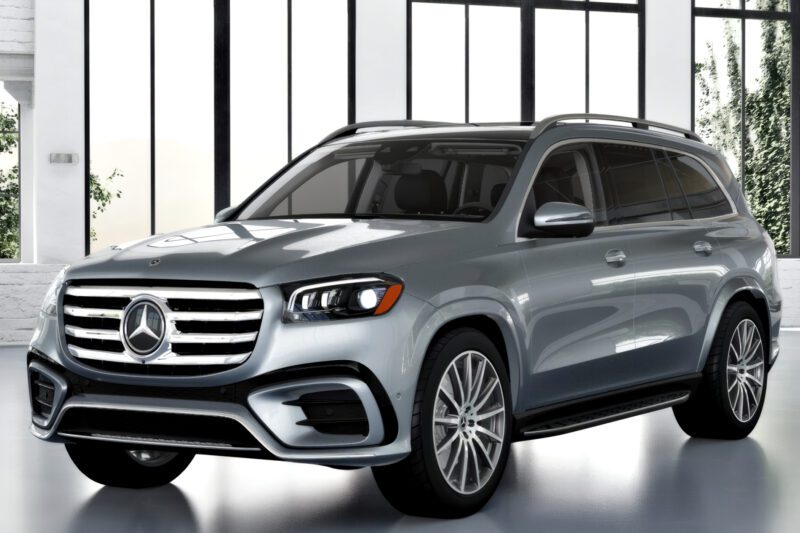
Mercedes also aids off-roading with an Off-road Cockpit screen that shows useful information such as individual wheel height, tire pressure and temperature, and steering angle. Forward and transparent hood views also let drivers see what’s just ahead of and even below the vehicle. The trade-off for the GLS 580’s size and power is fuel economy. It is EPA rated at 14 mpg city, 19 highway and 16 combined. I did slightly better than that, averaging 19.4 mpg over my 950-mile trip.
The powertrain was responsive enough for any situation in the Comfort drive mode, but the suspension needed to be firmed up. The GLS 580’s air springs and adaptive dampers team up to provide a smooth ride at all times, but the handling varies from slightly wobbly to controlled. With 7.9 inches of standard ground clearance, the GLS feels a bit top-heavy in Comfort, as road imperfections and driver inputs can cause some head toss for passengers. Wanting to be a better chauffeur for my passengers, I discovered that the Sport handling setting in the Individual drive mode reduced body lean and made the GLS feel more buttoned down.
Individual mode also lets drivers adjust the steering and stability control, though neither makes much difference and there is no reason to loosen the nannies to whip this nearly three-ton beast around corners. It leans too much in turns to be fun, but the GLS’s unibody structure makes it lighter, smoother, and better controlled than body-on-frame competitors like the Cadillac Escalade or Lincoln Navigator.
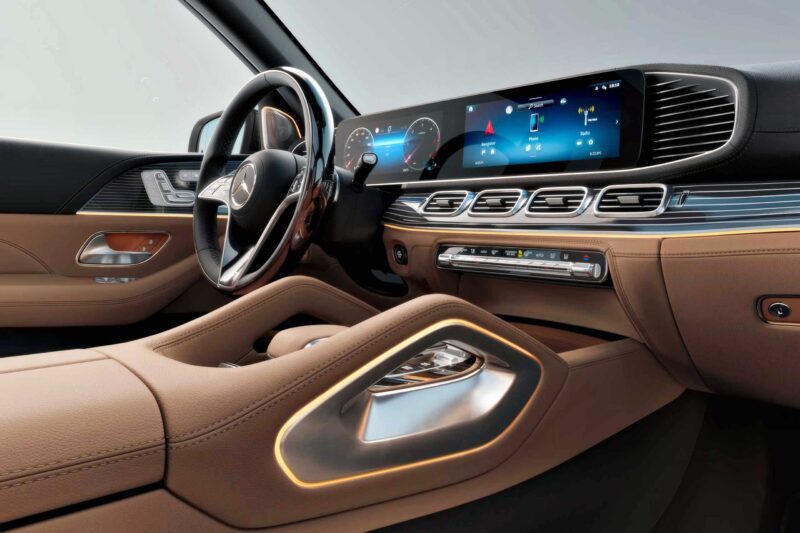
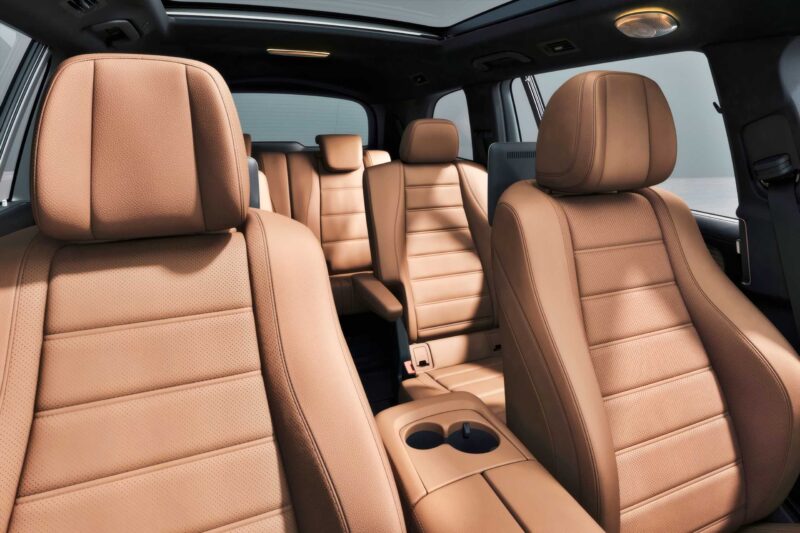
From the driver’s seat, the GLS 580 provides the comfort and technology for a great roadtripper. The multi-contour front seats are supportive and their standard head pillows add an extra bit of comfort. That’s only enhanced by the standard massaging seats. I loved both features, but, oddly, my best friend, going back to grade school, was bothered by both.
The 12.3-inch infotainment touchscreen runs some of the industry’s best software. I found it quick to react and easy to switch between satellite radio and Apple CarPlay. The screen can also be controlled via the steering wheel or a trackpad on the center console. That pad takes up valuable real estate that could better be used for storage. Mercedes also provides a 12.3-inch digital instrument cluster that can show a spate of useful information set within four different display themes.
My trip would have been more relaxing if the GLS 580 offered a hands-free driver-assist system along the lines of GM’s Super Cruise. The adaptive cruise control and lane keep assist in the GLS do maintain a lane, but they required me to keep my hands on the wheel. Mercedes does offer a Level 3 Drive Pilot system in the S-Class and EQS, but it only works in limited Western states.
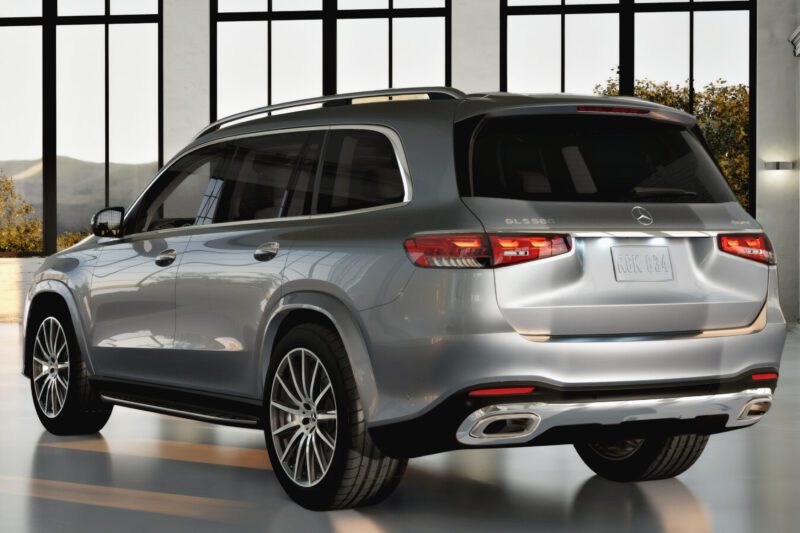
I drove with up to five passengers and the GLS accommodated them all well. The cargo hold had plenty of room for three gym bags and two coolers with the third row folded down (via power controls, of course). The GLS offers a modest 17.4 cubic feet of cargo space behind the third row, but that expands to a very useful 84.7 cubic feet with the second- and third-row seats folded flat.
Passenger space was also excellent. The second-row captain’s chairs provide bucket seat comfort and offer more than enough space for adults. The seats are also heated and passengers can control the two second-row climate zones via a small display screen with hard buttons.
The third row will also accommodate two adults and has its own climate zone. The bottom cushion sits high enough for good thigh support and headroom is sufficient for a six-footer. Legroom gets tight, however, if anyone in any row is tall.
My passengers had a few complaints. Most agreed that the running boards are tucked in too tightly to the body to be useful and they wished both second-row seats would tilt and slide forward to open a path to the third row. Instead, only the passenger side seat moves. There was also considerable boredom due to the monotonous landscape and the complaint about massaging seats and head pillows, but then again, there’s no accounting for taste!
View All Mercedes-Benz GLS For Sale
Images: Mercedes-Benz
Tags: Featured
Related Articles
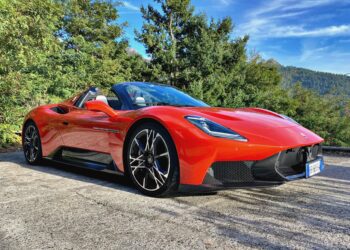
2026 Maserati MCPura Cielo First Drive
MC12 & MC20 Successor Is A Mid-Engined Italian Mountain Goat…
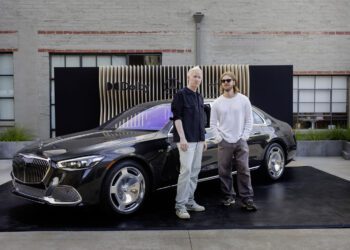
Mercedes Turns A Maybach Into A Rolling Music Studio
Mercedes-Benz combines automotive luxury with musical



